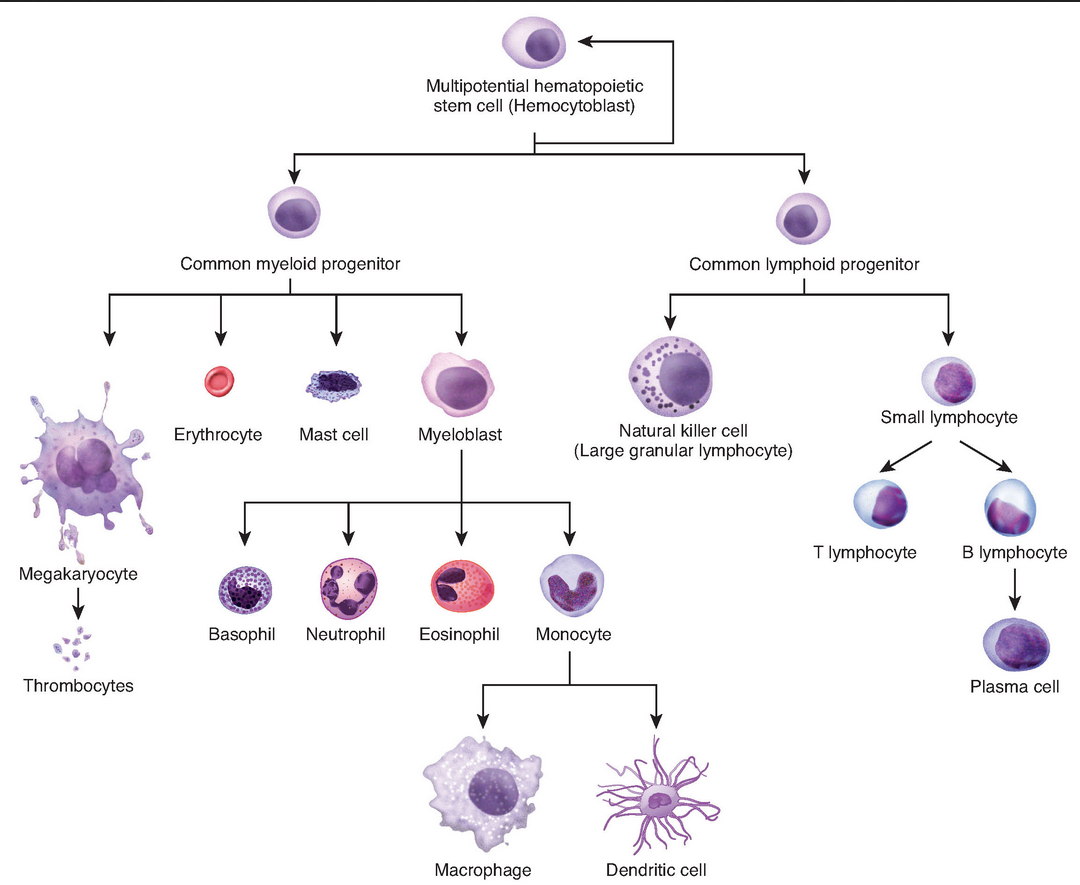єχтяαναgαηтєηzумє
Disease usually results from inconclusive negotiations for symbiosis, an overstepping of the line by one side or the other, a biological misinterpretation of the borders.
— Lewis Thomas
- 20 Posts
- 9 Comments

 113·2 months ago
113·2 months agoImmune cells form from stem cells. From start to finish in the stem cell differentiation process, four major changes occur. Some of these changes can have up to four potential outcomes each. Here’s a map:

While all cells react to their environment based on environmental stimuli and feedback loops, even bacteria and archaea, this is a great example of cell differentiation. All our cells started as stem cells, but the immune system’s continuous and consistent use of the process is very unique. It’s also the most elaborate and the image is surface level. Most the end cells pictured here will become more specific. Like there’s many different T-cells, even T-cells which change so much they don’t meet the classification of being a T-cell. The CD16 T-cell is a great example of this happening.
I feel like this is what you were looking for, but I’m not totally sure.

 5·2 months ago
5·2 months agoI’ve spent a good amount of time studying various DNA processes and never once made a connection between i-motifs and clippy. Great catch! lol
The thing is, our cells create these “knots” to make room for enzymes to access our DNA. They’re quite common as it’s required for DNA transcription + replication, chromosome segregation in cell division, telomere maintenance, and to alter gene expression. Not sure how I overlooked what happens if they form more often than intended. Wild to learn it can lead to cancer, neurodegeneration, and heart disorders! Guess I missed two massive aspects when studying all this, the imapct of DNA forming i-motifs too often, and the resemblance to clippy hahaha.

 4·2 months ago
4·2 months agoKind of, however, a nut contains sperm cells which are gametes. Only reproductive cells are gametes, as they need half the total DNA of all our other cells. This is what allows an eggs and sprem to make a new human. The coolest aspect here is how genetic variation is ensured during this process. But nonetheless, that mitochondrial DNA getting splattered all over your brain is from somatic cells. So it has twice the amount of DNA in it than a nut lol.

 7·2 months ago
7·2 months agoNaw, that’s just the fact mitochondria are the reason life is as we know it. It’s pretty much the cousin of chloroplast too!
But mitochondria actually forfeited a majority of its genome to the host organism when it became the powerhouse of the cell. This is how we influence it’s processes and output. It did retain enough of it’s genome to be able to synthesize the required proteins for the job, but all in all, the host is in control of the mitochondria.
 424·3 months ago
424·3 months agoExactly, more than half of registered voters are over 50. So polling 50+ year olds would definitely be better data.

 11·4 months ago
11·4 months agoWell, only very specific viruses entry the nucleus, most often due to not bringing along enzymes needed for replication. Then, there’s transducing viruses and non-transducing viruses, of which only one will retain it’s genome in the host genome. Both occur near oncogenic gene locations too, which is why viral infections can lead to cancer, but this isn’t very common at all. IDK, guess I’ve always felt bacteria are way more complex and that it makes sense CRISPR comes from them. Bacterial viruses, aka bacteria phages, were the evolutionary pressure which lead to CRISPR’s development. But I’m a nerd and stay up to date with it all, so maybe that shifted my outlook.

 11·4 months ago
11·4 months agoSorry for the delayed reply, but I studied in this field as welll, so curious why you thought CRISPR would be associated with viruses over bacteria or even mold/yeast?

 31·4 months ago
31·4 months agoIt was revolutionary when it was first isolated from bacteria. Always fascinating to me that it’s pretty much the bacterial adaptive immune system. Now it’s awesome seeing other scientists dial in the precision of an already game changing advancement.





I mean, cellular/molecular biology is applied organic chemistry. It’s all chemical based in some way or another. I guess with T and B cell receptor formations, each receptor binding domain is made totally at random. So much so, they go through training to ensure they won’t attack self and are able to detect pathogen associated molecular patterns. Wildly, most T and B cells don’t pass training and get recycled, more or less.
So maybe, but you’re talking about the world on the cellular level, it’s all based on chemical reactions with environmental stimuli. To be alive requires responding to your environment, and chemistry is how that works at the microscopic level.